* Fixed a double free issue when running multiple backends on the CPU, eg: CLIP and the primary backend, as this would result in the *_backend pointers both pointing to the same thing resulting in a segfault when calling the StableDiffusionGGML destructor. * Improve logging to allow for a color switch on the command line interface. Changed the base log_printf function to not bake the log level directly into the log buffer as that information is already passed the logging function via the level parameter and it's easier to add in there than strip it out. * Added a fix for certain SDXL LoRAs that don't seem to follow the expected naming convention, converts over the tensor name during the LoRA model loading. Added some logging of useful LoRA loading information. Had to increase the base size of the GGML graph as the existing size results in an insufficient graph memory error when using SDXL LoRAs. * small fixes --------- Co-authored-by: leejet <leejet714@gmail.com> |
||
|---|---|---|
| .github/workflows | ||
| assets | ||
| docs | ||
| examples | ||
| ggml@57869ad3b7 | ||
| thirdparty | ||
| .clang-format | ||
| .dockerignore | ||
| .gitignore | ||
| .gitmodules | ||
| CMakeLists.txt | ||
| Dockerfile | ||
| LICENSE | ||
| README.md | ||
| clip.hpp | ||
| common.hpp | ||
| control.hpp | ||
| denoiser.hpp | ||
| esrgan.hpp | ||
| format-code.sh | ||
| ggml_extend.hpp | ||
| lora.hpp | ||
| model.cpp | ||
| model.h | ||
| pmid.hpp | ||
| preprocessing.hpp | ||
| rng.hpp | ||
| rng_philox.hpp | ||
| stable-diffusion.cpp | ||
| stable-diffusion.h | ||
| tae.hpp | ||
| unet.hpp | ||
| upscaler.cpp | ||
| util.cpp | ||
| util.h | ||
| vae.hpp | ||
| vocab.hpp | ||
README.md
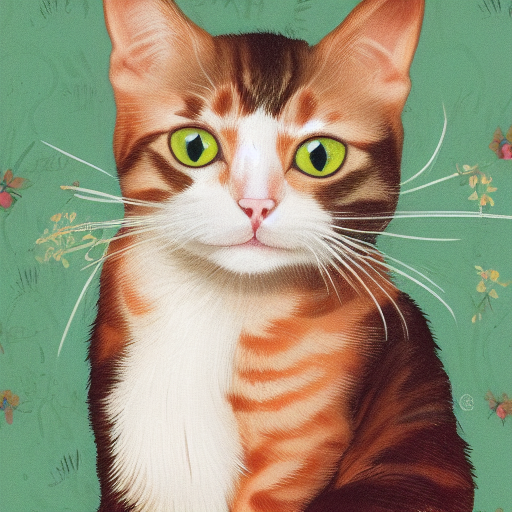
stable-diffusion.cpp
Inference of Stable Diffusion in pure C/C++
Features
-
Plain C/C++ implementation based on ggml, working in the same way as llama.cpp
-
Super lightweight and without external dependencies
-
SD1.x, SD2.x and SDXL support
- !!!The VAE in SDXL encounters NaN issues under FP16, but unfortunately, the ggml_conv_2d only operates under FP16. Hence, a parameter is needed to specify the VAE that has fixed the FP16 NaN issue. You can find it here: SDXL VAE FP16 Fix.
-
SD-Turbo and SDXL-Turbo support
-
PhotoMaker support.
-
16-bit, 32-bit float support
-
4-bit, 5-bit and 8-bit integer quantization support
-
Accelerated memory-efficient CPU inference
- Only requires ~2.3GB when using txt2img with fp16 precision to generate a 512x512 image, enabling Flash Attention just requires ~1.8GB.
-
AVX, AVX2 and AVX512 support for x86 architectures
-
Full CUDA and Metal backend for GPU acceleration.
-
Can load ckpt, safetensors and diffusers models/checkpoints. Standalone VAEs models
- No need to convert to
.ggmlor.ggufanymore!
- No need to convert to
-
Flash Attention for memory usage optimization (only cpu for now)
-
Original
txt2imgandimg2imgmode -
Negative prompt
-
stable-diffusion-webui style tokenizer (not all the features, only token weighting for now)
-
LoRA support, same as stable-diffusion-webui
-
Latent Consistency Models support (LCM/LCM-LoRA)
-
Faster and memory efficient latent decoding with TAESD
-
Upscale images generated with ESRGAN
-
VAE tiling processing for reduce memory usage
-
Control Net support with SD 1.5
-
Sampling method
Euler AEulerHeunDPM2DPM++ 2MDPM++ 2M v2DPM++ 2S aLCM
-
Cross-platform reproducibility (
--rng cuda, consistent with thestable-diffusion-webui GPU RNG) -
Embedds generation parameters into png output as webui-compatible text string
-
Supported platforms
- Linux
- Mac OS
- Windows
- Android (via Termux)
TODO
- More sampling methods
- Make inference faster
- The current implementation of ggml_conv_2d is slow and has high memory usage
- Continuing to reduce memory usage (quantizing the weights of ggml_conv_2d)
- Implement Inpainting support
- k-quants support
Usage
For most users, you can download the built executable program from the latest release. If the built product does not meet your requirements, you can choose to build it manually.
Get the Code
git clone --recursive https://github.com/leejet/stable-diffusion.cpp
cd stable-diffusion.cpp
- If you have already cloned the repository, you can use the following command to update the repository to the latest code.
cd stable-diffusion.cpp
git pull origin master
git submodule init
git submodule update
Download weights
-
download original weights(.ckpt or .safetensors). For example
- Stable Diffusion v1.4 from https://huggingface.co/CompVis/stable-diffusion-v-1-4-original
- Stable Diffusion v1.5 from https://huggingface.co/runwayml/stable-diffusion-v1-5
- Stable Diffuison v2.1 from https://huggingface.co/stabilityai/stable-diffusion-2-1
curl -L -O https://huggingface.co/CompVis/stable-diffusion-v-1-4-original/resolve/main/sd-v1-4.ckpt # curl -L -O https://huggingface.co/runwayml/stable-diffusion-v1-5/resolve/main/v1-5-pruned-emaonly.safetensors # curl -L -O https://huggingface.co/stabilityai/stable-diffusion-2-1/resolve/main/v2-1_768-nonema-pruned.safetensors
Build
Build from scratch
mkdir build
cd build
cmake ..
cmake --build . --config Release
Using OpenBLAS
cmake .. -DGGML_OPENBLAS=ON
cmake --build . --config Release
Using CUBLAS
This provides BLAS acceleration using the CUDA cores of your Nvidia GPU. Make sure to have the CUDA toolkit installed. You can download it from your Linux distro's package manager (e.g. apt install nvidia-cuda-toolkit) or from here: CUDA Toolkit. Recommended to have at least 4 GB of VRAM.
cmake .. -DSD_CUBLAS=ON
cmake --build . --config Release
Using HipBLAS
This provides BLAS acceleration using the ROCm cores of your AMD GPU. Make sure to have the ROCm toolkit installed.
Windows User Refer to docs/hipBLAS_on_Windows.md for a comprehensive guide.
cmake .. -G "Ninja" -DCMAKE_C_COMPILER=clang -DCMAKE_CXX_COMPILER=clang++ -DSD_HIPBLAS=ON -DCMAKE_BUILD_TYPE=Release -DAMDGPU_TARGETS=gfx1100
cmake --build . --config Release
Using Metal
Using Metal makes the computation run on the GPU. Currently, there are some issues with Metal when performing operations on very large matrices, making it highly inefficient at the moment. Performance improvements are expected in the near future.
cmake .. -DSD_METAL=ON
cmake --build . --config Release
Using Flash Attention
Enabling flash attention reduces memory usage by at least 400 MB. At the moment, it is not supported when CUBLAS is enabled because the kernel implementation is missing.
cmake .. -DSD_FLASH_ATTN=ON
cmake --build . --config Release
Run
usage: ./bin/sd [arguments]
arguments:
-h, --help show this help message and exit
-M, --mode [MODEL] run mode (txt2img or img2img or convert, default: txt2img)
-t, --threads N number of threads to use during computation (default: -1).
If threads <= 0, then threads will be set to the number of CPU physical cores
-m, --model [MODEL] path to model
--vae [VAE] path to vae
--taesd [TAESD_PATH] path to taesd. Using Tiny AutoEncoder for fast decoding (low quality)
--control-net [CONTROL_PATH] path to control net model
--embd-dir [EMBEDDING_PATH] path to embeddings.
--stacked-id-embd-dir [DIR] path to PHOTOMAKER stacked id embeddings.
--input-id-images-dir [DIR] path to PHOTOMAKER input id images dir.
--normalize-input normalize PHOTOMAKER input id images
--upscale-model [ESRGAN_PATH] path to esrgan model. Upscale images after generate, just RealESRGAN_x4plus_anime_6B supported by now.
--upscale-repeats Run the ESRGAN upscaler this many times (default 1)
--type [TYPE] weight type (f32, f16, q4_0, q4_1, q5_0, q5_1, q8_0)
If not specified, the default is the type of the weight file.
--lora-model-dir [DIR] lora model directory
-i, --init-img [IMAGE] path to the input image, required by img2img
--control-image [IMAGE] path to image condition, control net
-o, --output OUTPUT path to write result image to (default: ./output.png)
-p, --prompt [PROMPT] the prompt to render
-n, --negative-prompt PROMPT the negative prompt (default: "")
--cfg-scale SCALE unconditional guidance scale: (default: 7.0)
--strength STRENGTH strength for noising/unnoising (default: 0.75)
--style-ratio STYLE-RATIO strength for keeping input identity (default: 20%)
--control-strength STRENGTH strength to apply Control Net (default: 0.9)
1.0 corresponds to full destruction of information in init image
-H, --height H image height, in pixel space (default: 512)
-W, --width W image width, in pixel space (default: 512)
--sampling-method {euler, euler_a, heun, dpm2, dpm++2s_a, dpm++2m, dpm++2mv2, lcm}
sampling method (default: "euler_a")
--steps STEPS number of sample steps (default: 20)
--rng {std_default, cuda} RNG (default: cuda)
-s SEED, --seed SEED RNG seed (default: 42, use random seed for < 0)
-b, --batch-count COUNT number of images to generate.
--schedule {discrete, karras} Denoiser sigma schedule (default: discrete)
--clip-skip N ignore last layers of CLIP network; 1 ignores none, 2 ignores one layer (default: -1)
<= 0 represents unspecified, will be 1 for SD1.x, 2 for SD2.x
--vae-tiling process vae in tiles to reduce memory usage
--control-net-cpu keep controlnet in cpu (for low vram)
--canny apply canny preprocessor (edge detection)
-v, --verbose print extra info
Quantization
You can specify the model weight type using the --type parameter. The weights are automatically converted when loading the model.
f16for 16-bit floating-pointf32for 32-bit floating-pointq8_0for 8-bit integer quantizationq5_0orq5_1for 5-bit integer quantizationq4_0orq4_1for 4-bit integer quantization
Convert to GGUF
You can also convert weights in the formats ckpt/safetensors/diffusers to gguf and perform quantization in advance, avoiding the need for quantization every time you load them.
For example:
./bin/sd -M convert -m ../models/v1-5-pruned-emaonly.safetensors -o ../models/v1-5-pruned-emaonly.q8_0.gguf -v --type q8_0
txt2img example
./bin/sd -m ../models/sd-v1-4.ckpt -p "a lovely cat"
# ./bin/sd -m ../models/v1-5-pruned-emaonly.safetensors -p "a lovely cat"
# ./bin/sd -m ../models/sd_xl_base_1.0.safetensors --vae ../models/sdxl_vae-fp16-fix.safetensors -H 1024 -W 1024 -p "a lovely cat" -v
Using formats of different precisions will yield results of varying quality.
| f32 | f16 | q8_0 | q5_0 | q5_1 | q4_0 | q4_1 |
|---|---|---|---|---|---|---|
 |
 |
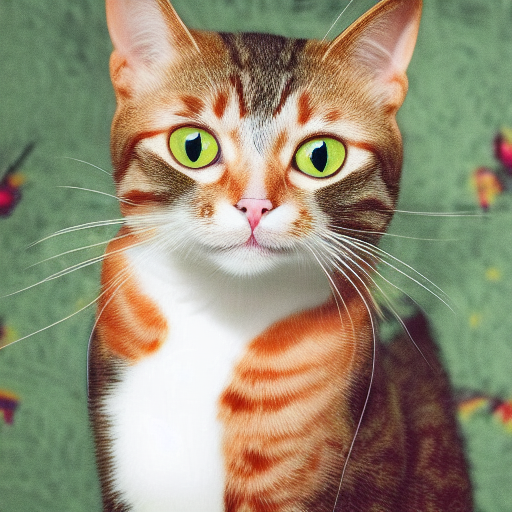 |
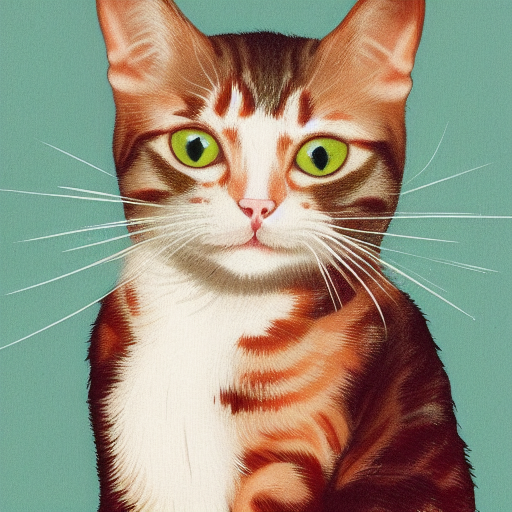 |
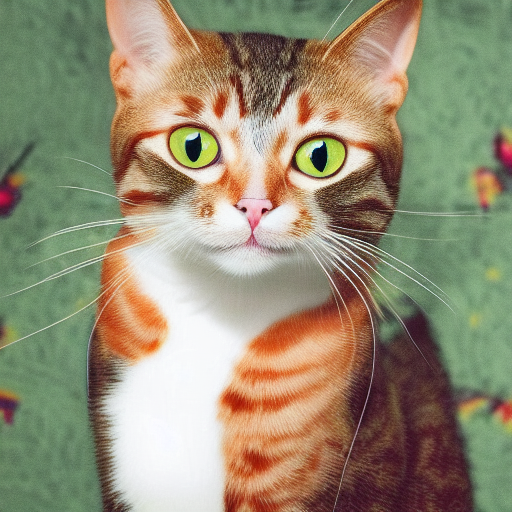 |
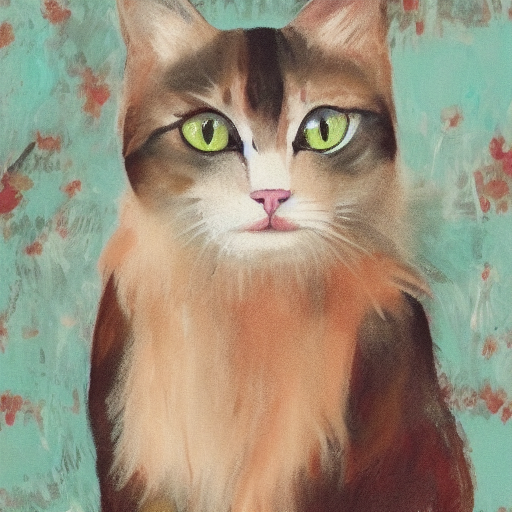 |
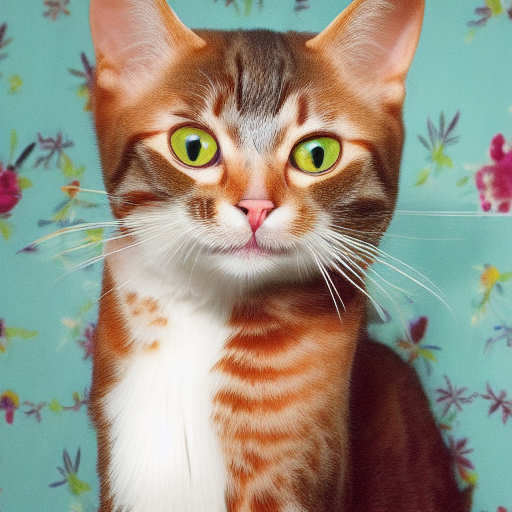 |
img2img example
./output.pngis the image generated from the above txt2img pipeline
./bin/sd --mode img2img -m ../models/sd-v1-4.ckpt -p "cat with blue eyes" -i ./output.png -o ./img2img_output.png --strength 0.4
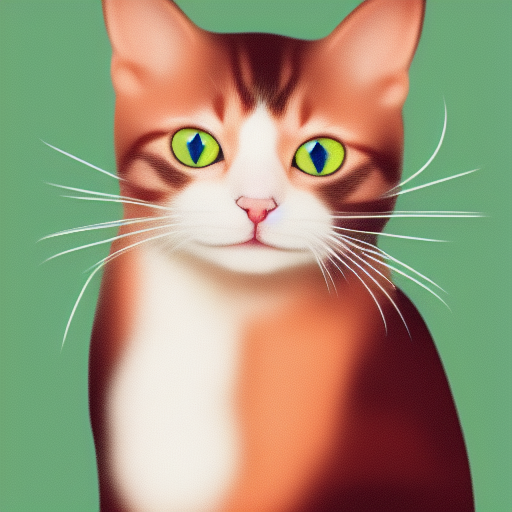
with LoRA
-
You can specify the directory where the lora weights are stored via
--lora-model-dir. If not specified, the default is the current working directory. -
LoRA is specified via prompt, just like stable-diffusion-webui.
Here's a simple example:
./bin/sd -m ../models/v1-5-pruned-emaonly.safetensors -p "a lovely cat<lora:marblesh:1>" --lora-model-dir ../models
../models/marblesh.safetensors or ../models/marblesh.ckpt will be applied to the model
LCM/LCM-LoRA
- Download LCM-LoRA form https://huggingface.co/latent-consistency/lcm-lora-sdv1-5
- Specify LCM-LoRA by adding
<lora:lcm-lora-sdv1-5:1>to prompt - It's advisable to set
--cfg-scaleto1.0instead of the default7.0. For--steps, a range of2-8steps is recommended. For--sampling-method,lcm/euler_ais recommended.
Here's a simple example:
./bin/sd -m ../models/v1-5-pruned-emaonly.safetensors -p "a lovely cat<lora:lcm-lora-sdv1-5:1>" --steps 4 --lora-model-dir ../models -v --cfg-scale 1
| without LCM-LoRA (--cfg-scale 7) | with LCM-LoRA (--cfg-scale 1) |
|---|---|
 |
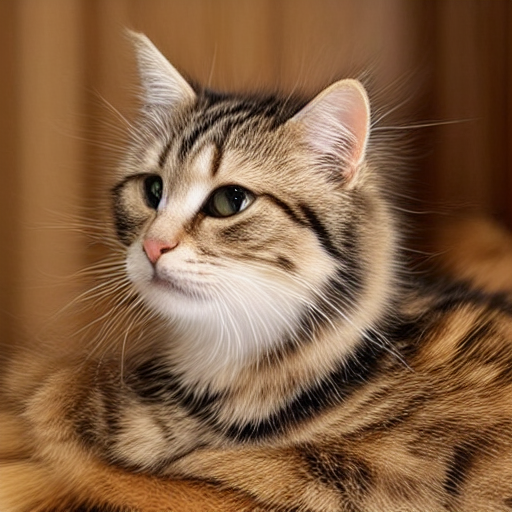 |
Using TAESD to faster decoding
You can use TAESD to accelerate the decoding of latent images by following these steps:
- Download the model weights.
Or curl
curl -L -O https://huggingface.co/madebyollin/taesd/blob/main/diffusion_pytorch_model.safetensors
- Specify the model path using the
--taesd PATHparameter. example:
sd -m ../models/v1-5-pruned-emaonly.safetensors -p "a lovely cat" --taesd ../models/diffusion_pytorch_model.safetensors
Using ESRGAN to upscale results
You can use ESRGAN to upscale the generated images. At the moment, only the RealESRGAN_x4plus_anime_6B.pth model is supported. Support for more models of this architecture will be added soon.
- Specify the model path using the
--upscale-model PATHparameter. example:
sd -m ../models/v1-5-pruned-emaonly.safetensors -p "a lovely cat" --upscale-model ../models/RealESRGAN_x4plus_anime_6B.pth
Using PhotoMaker to personalize image generation
You can use PhotoMaker to personalize generated images with your own ID.
NOTE, currently PhotoMaker ONLY works with SDXL (any SDXL model files will work).
Download PhotoMaker model file (in safetensor format) here. The official release of the model file (in .bin format) does not work with stablediffusion.cpp.
- Specify the PhotoMaker model path using the
--stacked-id-embd-dir PATHparameter. - Specify the input images path using the
--input-id-images-dir PATHparameter.- input images must have the same width and height for preprocessing (to be improved)
In prompt, make sure you have a class word followed by the trigger word "img" (hard-coded for now). The class word could be one of "man, woman, girl, boy". If input ID images contain asian faces, add Asian before the class
word.
Another PhotoMaker specific parameter:
--style-ratio (0-100)%: default is 20 and 10-20 typically gets good results. Lower ratio means more faithfully following input ID (not necessarily better quality).
Other parameters recommended for running Photomaker:
--cfg-scale 5.0-H 1024-W 1024
If on low memory GPUs (<= 8GB), recommend running with --vae-on-cpu option to get artifact free images.
Example:
bin/sd -m ../models/sdxlUnstableDiffusers_v11.safetensors --vae ../models/sdxl_vae.safetensors --stacked-id-embd-dir ../models/photomaker-v1.safetensors --input-id-images-dir ../assets/examples/scarletthead_woman -p "a girl img, retro futurism, retro game art style but extremely beautiful, intricate details, masterpiece, best quality, space-themed, cosmic, celestial, stars, galaxies, nebulas, planets, science fiction, highly detailed" -n "realistic, photo-realistic, worst quality, greyscale, bad anatomy, bad hands, error, text" --cfg-scale 5.0 --sampling-method euler -H 1024 -W 1024 --style-ratio 10 --vae-on-cpu -o output.png
Docker
Building using Docker
docker build -t sd .
Run
docker run -v /path/to/models:/models -v /path/to/output/:/output sd [args...]
# For example
# docker run -v ./models:/models -v ./build:/output sd -m /models/sd-v1-4.ckpt -p "a lovely cat" -v -o /output/output.png
Memory Requirements
| precision | f32 | f16 | q8_0 | q5_0 | q5_1 | q4_0 | q4_1 |
|---|---|---|---|---|---|---|---|
| Memory (txt2img - 512 x 512) | ~2.8G | ~2.3G | ~2.1G | ~2.0G | ~2.0G | ~2.0G | ~2.0G |
| Memory (txt2img - 512 x 512) with Flash Attention | ~2.4G | ~1.9G | ~1.6G | ~1.5G | ~1.5G | ~1.5G | ~1.5G |
Bindings
These projects wrap stable-diffusion.cpp for easier use in other languages/frameworks.
Contributors
Thank you to all the people who have already contributed to stable-diffusion.cpp!